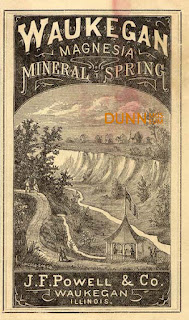 Trade between Europeans and Great Lakes Native Americans began in 1634 when French trader, Jean Nicolet (1598-1642), arrived in the area of present-day Greenbay, Wisconsin.
Trade between Europeans and Great Lakes Native Americans began in 1634 when French trader, Jean Nicolet (1598-1642), arrived in the area of present-day Greenbay, Wisconsin. The arrival of the French explorer was depicted by Edwin Willard Deming in his 1904 painting "The Landfall of Jean Nicolet" commissioned by the Wisconsin Historical Society.
Nicolet was a prominent French explorer who, for many years, lived among the Indigenous peoples of Quebec. In 1634, Samuel de Champlain, the Governor of New France, sent Nicolet west on a journey to explore the great interior. There was an expectation that he would reach Asia by this route, and Nicolet fully expected to encounter Asian peoples. With this in mind, he donned a Chinese damask robe to greet them but met, instead, a small group of Menomonee Indians.
This encounter marked the beginning of trade between the French and native peoples in this region. The silver and fur trade prospered from 1680 to 1820. In exchange for fur, Native Americans were given goods such as silver armbands, rifles, gunpowder, and wool blankets.
 Silver was popular with Native Americans who felt it was a gift from the underworld and its radiant quality reflected the power of the upper world. They believed that there were key points on the body at which evil spirits could enter (fingertips, nose, heart, etc), but wearing silver prevented this. The trade items were designed with this belief in mind, and took such forms as nose rings, wristbands, finger rings, hair ornaments and gorgets.
Silver was popular with Native Americans who felt it was a gift from the underworld and its radiant quality reflected the power of the upper world. They believed that there were key points on the body at which evil spirits could enter (fingertips, nose, heart, etc), but wearing silver prevented this. The trade items were designed with this belief in mind, and took such forms as nose rings, wristbands, finger rings, hair ornaments and gorgets. In this painting from 1776, Joseph Brant (Thayendanegea)(1743 – 1807) wears silver, not simply as decoration but to dispel evil spirits. Brant was a Mohawk born somewhere along the Cuyahoga River, and became a military and political leader allied with Great Britian. Portrait of Mohawk, Joseph Brant, from National Heritage Museum.
Since native peoples already created and appreciated finely crafted items made of stone, wood, leather, quill and beads, they would not accept inferior silver products from traders. One of the most popular trade items were silver crosses, in particular double crosses (Cross of Lorraine). For Native Americans, the shape of the double crosses was much like a dragonfly, and typically not seen as a Christian symbol.
In 1889, excavation work near Waukegan's Sugar Refinery uncovered silver objects and human remains. It is unknown if the human remains were of Native or European origins.
Waukegan (previously known as Little Fort) may have been established as a French trading post as early as 1695. The region was part of the vast silver trade network, which by 1768 was dominated by the Potawatomi.
Some people thought the items recovered in 1889 were a hoax, and the items disappeared from public view. In 1917, several items resurfaced in the possession of C.T. Heydecker.
Edward DeWolf's handwritten note from 1917, regarding the silver crosses and remains in the possession of C.T. Heydecker. DeWolf Collection, Dunn Museum.
Detail of Edward DeWolf's 1917 photograph of the silver crosses and brooch found in Waukegan.
DeWolf Collection, Dunn Museum.
The silver crosses bore the markings of "RC" and "CA." At the time, locals thought the initials were those of Jesuit missionaries. Contemporary research leans towards identifying the mark "RC" for professional silversmith, Robert Cruickshank (c. 1748-1809) of Montreal Canada. "CA" may be the mark of Charles Arnoldi also of Montreal, and possibly Cruickshank's partner. Apprentices were also allowed to make items and use their master's mark.
Two of the crosses again turned up in 1960 in private hands, and were brought to the attention of Robert Vogel, Director of the Lake County Museum of History. Vogel was asked to authenticate the crosses and enlisted the help of Fansteel Metalurgical Corp. in North Chicago. One cross had 5-10% copper, and the remainder silver; the other cross had 10-20% copper, a little gold, and silver.
Two of the crosses again turned up in 1960 in private hands, and were brought to the attention of Robert Vogel, Director of the Lake County Museum of History. Vogel was asked to authenticate the crosses and enlisted the help of Fansteel Metalurgical Corp. in North Chicago. One cross had 5-10% copper, and the remainder silver; the other cross had 10-20% copper, a little gold, and silver.
Vogel was the first to dispel the notion that the crosses were those of a Jesuit missionary, and asserted they were trade items.
The trail of the crosses runs cold after Vogel's research. The silver crosses may still be nestled in the homes of Lake County citizens, who may or may not realize their significance. It is hoped, though it is difficult to confirm, that many of the items discovered in 1889 made their way to one or more museums in Chicago.
The trail of the crosses runs cold after Vogel's research. The silver crosses may still be nestled in the homes of Lake County citizens, who may or may not realize their significance. It is hoped, though it is difficult to confirm, that many of the items discovered in 1889 made their way to one or more museums in Chicago.





































